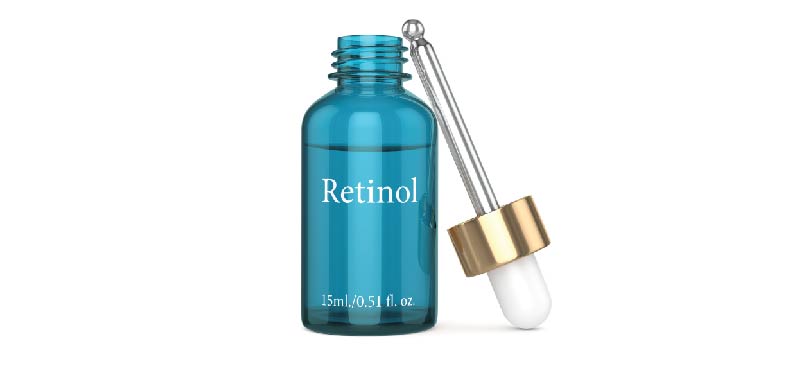
Retinoids, or topical forms of vitamin A, are some of the “most used and most studied anti-aging compounds,” according to Harvard Health Publishing. Whether applied as a retinoid cream for acne, an overnight serum for wrinkles or even as a prescription-strength treatment, products containing this compound have been shown to help keep skin healthy in a number of ways.
What Is a Retinoid?
Retinoids are a group of vitamin A-containing compounds. They are used primarily to help improve skin’s health and appearance because they can help regulate epithelial cell growth.
Retinoid vs. Retinol
What is the difference between retinol and retinoid? The term retinoids describes a variety of products that contain retinol.
Retinol is converted into retinoic acid, the form of vitamin A that actually repairs skin. Studies have found that retinoic acid, the active ingredient in prescription creams, is usually more potent than retinol.
Retinoids are derived from both animal sources and plants that contain active retinol or inactive vitamin A (in the form of beta-carotene, which must be converted).
The terminology can be confusing, considering there are a number of skincare products that contain ingredients called by similar names, all starting with “R” (retinol, retinoic acid, Retin-A, etc.). Overall, research shows these products tend to have similar effects and uses, however the strength/concentration of the product and how long it’s used determine how effective it is likely to be.
Types/Varieties
You can find retinoid products in both over-the-counter and prescription forms. Creams, serums and other skincare formulas that are labeled as “retinol” and available in drug or department stores don’t require a prescription.
Prescription retinoids have been used since the 1970s. The first type, under the brand name Retin-A (drug name tretinoin), was originally created to help treat acne.
Today it’s still prescribed by dermatologists, now for reasons beyond clearing breakouts.
Prescription formulas mostly contain retinoic acid, which is already in its “active form” and doesn’t need to be converted once applied to the skin. Retinol is described as being “more gentle than retinoic acid,” however the two can provide similar results when used consistently.
Additionally, there’s another group of products called “pro-retinols” (also referred to as retinyl palmitate, retinyl acetate and retinyl linoleate). These are the most gentle and least likely to cause side effects, but they are also weaker and may take longer to provide benefits.
What are examples of retinoid products?
Whether at the drugstore or with help from your dermatologist, you can find liquid, gel and other products, including retinoid cream, retinoid pills (oral retinoids), serums and more. Gels are recommended for people with oilier skin, while creams are best for those prone to dryness.
Types of retinoids include:
- alitretinoin
- isotretinoin
- tretinoin
- etretinate
- acitretin
- tazarotene
- adapalene,
- differin
- seletinoid G
Retinoid prescriptions include:
- Tretinoin (Retin-A, generic)
- Tazarotene (Avage, Tazorac)
- Adapalene (Differin)
- Alitretinoin
- Bexarotene
- Isotretinoin (Accutane) which is taken by mouth
Benefits/Uses
Do retinoids really work? Studies suggest that retinoid benefits may include:
- Decreasing acne
- Reducing fine lines and wrinkles by preventing degradation of the dermal matrix damaged by UV exposure
- Fading actinic keratosis spots (which can be precancerous skin cells)
- Evening pigmentation, fading age spots and improving skin’s overall tone/color
- Speeding the turnover of superficial skin cells
- Fighting psoriasis and warts
- Treating pigmentary disorders
- Preventing water loss in the skin
- Potentially helping fight certain types of skin cancers, due to how retinoids regulate cell apoptosis, differentiation and proliferation
Here’s more about how retinoid products work:
1. Can Help Fight Signs of Aging
Vitamin A and retinol have been shown to regulate numerous transcription factors located within the nucleus of various cells. This means they can boost skin health at the cellular level.
Research has shown that retinoid beauty treatments can help prevent wrinkles, lines and age spots in several ways, including by boosting production of collagen and preventing collagen loss. Collagen is a protein that helps to form the skin, as well as other connective tissues throughout the body.
Another mechanism is by stimulating the production of new blood vessels in the skin.
People using retinoid cream and serums tend to notice that their skin appears more elastic and firmer. For even stronger anti-aging effects, some people choose to combine retinoid creams (such as tretinoin, the most potent and widely used therapy for photo-aging) with alpha hydroxy acids (AHAs).
2. Fights Acne
Retinoids are one of the most commonly prescribed products by dermatologist for treatment of mild to moderate acne. According to the American Academy of Dermatology, “retinoids are the core of topical therapy for acne because they are comedolytic, resolve the precursor microcomedone lesion, are anti-inflammatory, and allow for maintenance of clearance.”
In other words, they can help stop breakouts by unclogging blocked pores and removing dead skin cells. They also work with topical antibiotics to eradicate bacteria that lead to acne.
When someone has moderate to severe acne, retinoid pills may be prescribed. These can help treat oil production, kill bacteria and reduce inflammation, although side effects are common.
READ RELATED: The 29 Best Black Friday Skin Care Deals in 2022: Sunday Riley, Lancome, NuFace
3. Helps Improve Skin Tone/Pigmentation
What’s impressive about retinol is its ability to affect skin at not only the cellular level, but also at the genetic level. Studies show these products can affect gene expressions in a way that results in smoother skin, softening of rough patches and more even pigmentation.
Retinoids also are used for treatment of pigmentary disorders, some of which are normally difficult to manage. They may help reduce symptoms caused by post-inflammatory hyperpigmentation, melasma and actinic lentigines.
4. Can Reduce Psoriasis Symptoms
Retinoids can help to decrease hyperproliferation and shedding of epidermal skin cells that contributes to psoriasis. They are also used to control inflammation and restore normal epidermal differentiation.
Related: Benzoyl Peroxide for Acne: Benefits, Uses, Side Effects & More
Myths
Despite what many people think, here are some common myths about retinoids that turn out to NOT be true:
- If they cause irritation, you should stop using them. The truth: It’s common for these products to cause mild reactions, such as redness, dryness and even some peeling for the first one to two weeks. You can continue to use small amounts while your skin adjusts, as long as your reaction isn’t serious or painful.
- Stronger products are better. The truth: Using a concentrated product may be too much for your skin to handle at first, which can trigger strong side effects. It’s best to start by using a weaker product, and then once you know it’s well-tolerated, move to a stronger retinoid gradually. Some dermatologists consider tazarotene to be stronger than tretinoin, while adapalene is thought to be the gentlest.
- They smooth skin via exfoliation. The truth: Unlike other ingredients that actually exfoliate the skin by removing dead skin cells, retinoids work differently at the cellular level. They may cause your skin to peel, but this isn’t actually what provides the smoothing benefits.
- They work quickly. The truth: You probably won’t notice real result unless you use retinoids regularly for about 12 weeks or more.
Dosage
Retinoid cream tends to be strong, depending on the type, so usually applying just few drops or a pea-size amount is enough to see results. If you’re using a retinoid prescription, follow your doctor’s dosage recommendation carefully, which is important to avoid side effects.
Topical retinoids sold over-the-counter are usually available in 0.1 percent strength formulation, while prescriptions may contain 0.3 percent retinol. Ideally purchase a product packaged in aluminum, since this protects the formula from changing due to air and light exposure.
When first beginning to use these products, apply them only every third day or every other day in order to give your skin time to adjust. Then gradually work your way up to nightly applications each day, as long as you don’t experience adverse effects.
Most experts recommend using retinol cream, serum, etc., at night because sunlight can change the way this ingredient works. You may absorb the product best if you wait 15 to 20 minutes after washing your face before applying.
Because retinoids may increase peeling and redness (although not necessarily photosensitivity, according to some recent studies), most dermatologists recommend wearing sunscreen during the day when using these products and/or being careful about limiting exposure to direct sunlight.
Where on your face should you apply these products?
You can put it all over your face, right up to your eyes (but not in your eyes) in a thin layer. Apply your favorite moisturizer right on top.
You can also apply it to your neck, chest, hands and forearms.
How long do you need to use retinoid products to see improvements in your skin?
Most studies have found that it takes about three to six months of regular use before seeing noticeable results. Most people achieve the best results if using retinoid creams and other products for about six to 12 months.
Want to try making your own retinol cream at home?
Try this recipe for a DIY Rosehip Retinol Cream with Lavender. This skin-nourishing recipes uses moisturizing and anti-aging ingredients like rosehip seed oil, carrot seed oil, shea butter, green tea extract, lavender essential oil and frankincense oil.
Risks and Side Effects
Are retinoids safe? While they are generally safe for most people when used in recommended doses, some people may experience negative reactions when using retinoid products, especially if they have sensitive skin or use too much.
Side effects are most common when beginning to use retinoids or when switching to a stronger product.
It’s possible for retinoid side effects to include:
- Skin dryness and peeling
- Redness and irritation
- Sunburns
- Mild burning sensations or warmth to the skin
- Stinging and tingling
- Itching
- Mild discoloration of the skin
To limit side effects, use a small amount at first of a weaker product. You can also moisturize over your retinoid to avoid excess dryness.
Additionally, be careful not to over-wash your face, which can increase irritation, or to spend too much time in the sun.
If you notice any signs of an allergic reaction, such as hives and swelling, stop using this product and consult your doctor. If you’re pregnant or breastfeeding, get your doctor’s opinion before using these products.
Conclusion
- What is a retinoid? Retinoids are skincare products that contain the ingredient retinol, which is a derivative of vitamin A.
- Retin-A is a popular type of retinoid cream that requires a prescription. There are also many other types available over-the-counter that can be effective too.
- Benefits of these products include treating acne, wrinkles, dark spots, uneven pigmentation, clogged pores and skin inflammation.
- It’s best to start with a weaker product at first to give your skin time to adjust. Then consider using a stronger product, such as one available in strengths of about 0.3 percent.
- Some side effects may initially occur, such as redness, dryness and peeling. These should resolve within several weeks.
- The best results are seen when these products are used for at least 12 weeks, ideally up to one year.
Source: Dr. Axe






